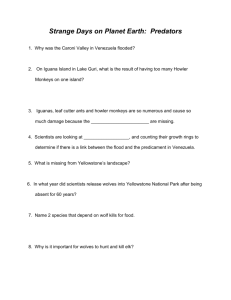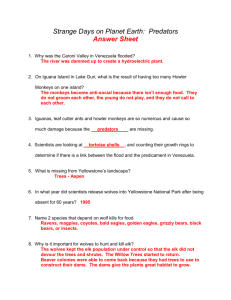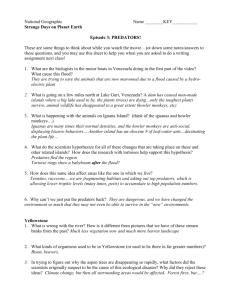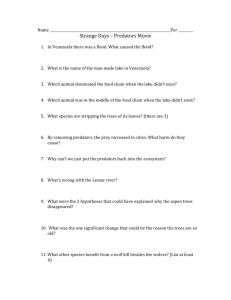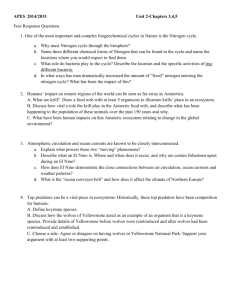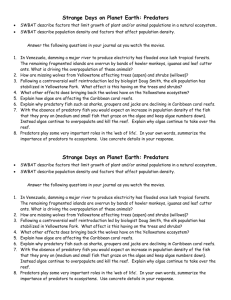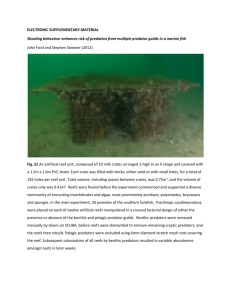Strange Days on Planet Earth-predators
advertisement
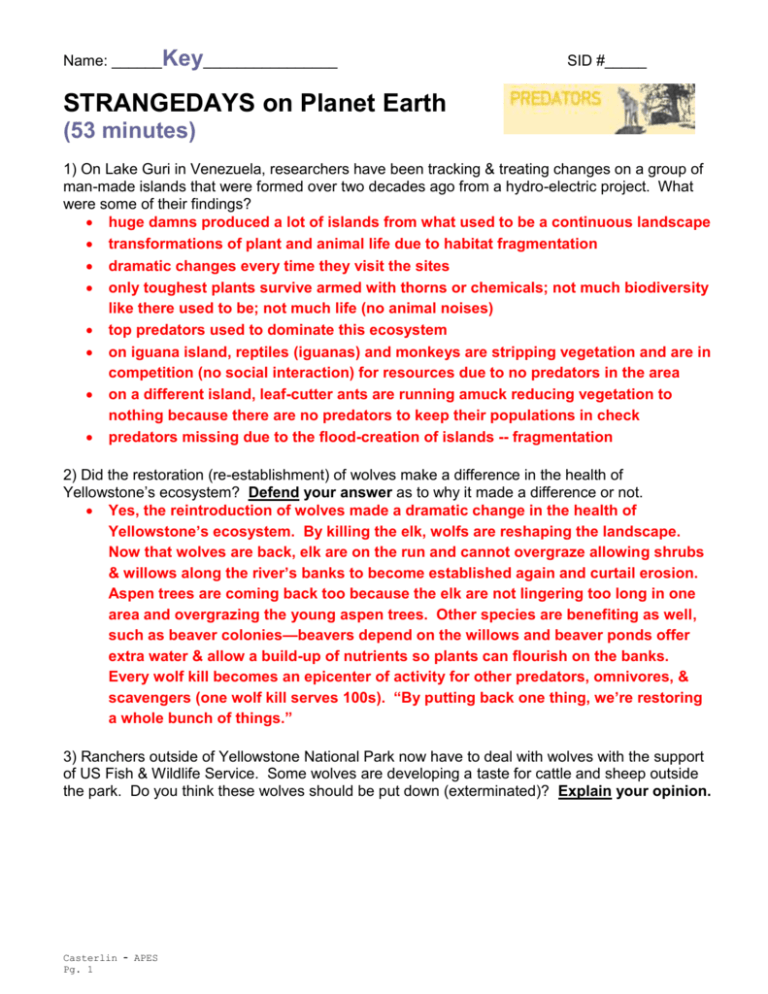
Name: ______Key________________ SID #_____ STRANGEDAYS on Planet Earth (53 minutes) 1) On Lake Guri in Venezuela, researchers have been tracking & treating changes on a group of man-made islands that were formed over two decades ago from a hydro-electric project. What were some of their findings? huge damns produced a lot of islands from what used to be a continuous landscape transformations of plant and animal life due to habitat fragmentation dramatic changes every time they visit the sites only toughest plants survive armed with thorns or chemicals; not much biodiversity like there used to be; not much life (no animal noises) top predators used to dominate this ecosystem on iguana island, reptiles (iguanas) and monkeys are stripping vegetation and are in competition (no social interaction) for resources due to no predators in the area on a different island, leaf-cutter ants are running amuck reducing vegetation to nothing because there are no predators to keep their populations in check predators missing due to the flood-creation of islands -- fragmentation 2) Did the restoration (re-establishment) of wolves make a difference in the health of Yellowstone’s ecosystem? Defend your answer as to why it made a difference or not. Yes, the reintroduction of wolves made a dramatic change in the health of Yellowstone’s ecosystem. By killing the elk, wolfs are reshaping the landscape. Now that wolves are back, elk are on the run and cannot overgraze allowing shrubs & willows along the river’s banks to become established again and curtail erosion. Aspen trees are coming back too because the elk are not lingering too long in one area and overgrazing the young aspen trees. Other species are benefiting as well, such as beaver colonies—beavers depend on the willows and beaver ponds offer extra water & allow a build-up of nutrients so plants can flourish on the banks. Every wolf kill becomes an epicenter of activity for other predators, omnivores, & scavengers (one wolf kill serves 100s). “By putting back one thing, we’re restoring a whole bunch of things.” 3) Ranchers outside of Yellowstone National Park now have to deal with wolves with the support of US Fish & Wildlife Service. Some wolves are developing a taste for cattle and sheep outside the park. Do you think these wolves should be put down (exterminated)? Explain your opinion. Casterlin – APES Pg. 1 4) Clues to predators’ significance are beginning to emerge in the Caribbean Ocean. The deaths of coral reefs are associated with the absence of top predatory fish. Explain the correlation: Coral reefs are suffocating under a layer of algae. Reefs are built from colonies of tiny animals called polyps; only the top layer of a reef is alive & beneath are skeletons of past generations. Samples from coral tubes (capturing over a millennium of history) show that algae started to take over reefs in the 1980s, which stopped the coral from growing; this leads scientists to believe it has to do with human impact, since it has only occurred w/in the last few decades. We have lost about 90% of all large fish around the world; boats continue to remove big predatory fish; and we continue to do it near the reefs along with removing (fishing) their prey; we keep fishing down the food web. Herbivores are vital to reefs—their grazing helps keep fast growing algae in check so when we fish out all the herbivores, the coral suffocates and dies. 5) Are pests in our subdivisions (raccoons, squirrels, armadillos, moles), the decline of coral reefs in our oceans, and the vanishing of trees all linked to the disappearance of predators? Defend (support) your opinion. Your Natural Heritage Maybe you've had the opportunity to see a mountain lion in the wild. Perhaps you've seen a pack of wolves in our national parks. It's perhaps more likely you've just spied a top predator on your television screen. Whatever the case, it's hard not to be stirred by the presence of these spectacular creatures. You might be taken by their beauty, impressed by their power and cunning or simply in awe that such animals still exist. Without large predators, many believe that all of our lives — and the lives of future generations — will be diminished. Casterlin – APES Pg. 2 Name: _______________________________________ SID #______ STRANGEDAYS on Planet Earth (53 minutes) 1) On Lake Guri in Venezuela, researchers have been tracking & treating changes on a group of man-made islands that were formed over two decades ago from a hydro-electric project. What were some of their findings? 2) Did the restoration (re-establishment) of wolves make a difference in the health of Yellowstone’s ecosystem? Defend your answer as to why it made a difference or not. 3) Ranchers outside of Yellowstone National Park now have to deal with wolves with the support of US Fish & Wildlife Service. Some wolves are developing a taste for cattle and sheep outside the park. Do you think these wolves should be put down (exterminated)? Explain your opinion. Casterlin – APES Pg. 1 4) Clues to predators’ significance are beginning to emerge in the Caribbean Ocean. The deaths of coral reefs are associated with the absence of top predatory fish. Explain the correlation: 5) Are pests in our subdivisions (raccoons, squirrels, armadillos, moles), the decline of coral reefs in our oceans, and the vanishing of trees all linked to the disappearance of predators? Defend (support) your opinion. Your Natural Heritage Maybe you've had the opportunity to see a mountain lion in the wild. Perhaps you've seen a pack of wolves in our national parks. It's perhaps more likely you've just spied a top predator on your television screen. Whatever the case, it's hard not to be stirred by the presence of these spectacular creatures. You might be taken by their beauty, impressed by their power and cunning or simply in awe that such animals still exist. Without large predators, many believe that all of our lives — and the lives of future generations — will be diminished. Casterlin – APES Pg. 2
